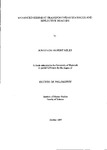ENHANCED SEDIMENT TRANSPORT NEAR SEAWALLS AND REFLECTIVE BEACHES
| dc.contributor.author | MILES, JONATHON RUPERT | |
| dc.contributor.other | School of Biological and Marine Sciences | en_US |
| dc.date.accessioned | 2013-09-19T14:09:30Z | |
| dc.date.available | 2013-09-19T14:09:30Z | |
| dc.date.issued | 1997 | |
| dc.identifier | NOT AVAILABLE | en_US |
| dc.identifier.uri | http://hdl.handle.net/10026.1/1901 | |
| dc.description.abstract |
This thesis describes results of a field experiment to examine the effect of wave reflection on suspended sediment transport in front of a seawall. Two instrument rigs were set up on the beach at Teignmouth, South Devon, U.K., in June 1995. One rig (the seawall rig) was attached to a protruding section of seawall, positioning the instruments 1.2m seaward of the wall. The other rig (the beach rig) acted as a control and was positioned 135m downcoast where the seawall is set back so that conditions were those of a natural beach. At each rig high frequency measurements of wave elevation, current velocity and suspended sediment concentrations were made using pressure transducers (PTs), bi-axial electromagnetic current meters (EMCMs) and optical backscatter sensors (OBSs) respectively. Wave heights during the experiment were typically in the range 0.1 <Ho<0.3m in deep water outside the surf zone and incident wave periods were around 4 seconds. Measurements were made in a range of water depths from 0.5m to 2.5m. At the natural beach, the reflection coefficient (R = reflected wave amplitude / incident wave amplitude) was found to be dependent on frequency, with low frequency waves (f<0.08Hz) being preferentially reflected (0.7<R<0.9), while incident waves (O.I<f<0.45Hz) were dissipated (O.1<R<0.2). In front of the seawall the incident wave reflection coefficient was high (0.75<R<0.9), indicating only a small amount of dissipation and thus an effective doubling of energy over the sea bed. This was found to increase the suspended sediment concentrations in the water column. For similar water depths (-0.5m), and instrument heights (~ -0.2m) instantaneous maximum sediment concentrations in front of the wall reached 9kg/m3, compared with only 1.2kg/m3 on the adjacent natural beach, despite similar incident wave conditions. Mean suspended sediment concentrations in front of the wall were also enhanced, ranging from 0.08kg/m3 to 2.8kg/m3, while at the beach rig values were typically in the range 0.08kg/m to 0.8kg/m3. At the seawall, mean and maximum suspended sediment concentrations were found to be dependent on water depth. Suspended sediment concentrations increased with decreasing depth. Guza et al.'s (1984) time domain method for separating incoming and outgoing waves was adapted to allow the incoming and outgoing wave contributions to the cross-shore sediment transport to be analysed. Incoming waves transported sediment onshore in both beach and wall cases, with typical values of the oscillatory transport associated with the incoming waves being 0.0005 < Ujn'Cs'bcach < 0.011 kg/m2/s and 0.0011 < Uin'Cs'u^i < 0.0187kg/m2/s. At the beach this resulted in a net onshore sediment transport by the waves, while in front of the wall offshore sediment transport associated with the reflected (outgoing) waves balanced the onshore sediment transport. Although the net cross-shore transport in front of the wall in this case was therefore reduced by wave reflection, the gross cross-shore transport was increased by a factor of two. Sediment accretion which was observed at the top of the natural beach was not observed in front of the wall, implying that the presence of the wall inhibited beach recovery in these accretionary conditions. Mean cross-shore sediment transport rates were also larger at the wall than at the beach. Typical values were u Cs wall = 0.05kg/m2/s compared with u Cs beach = 0.002kg/m2/s. This was attributed to the larger values of mean sediment concentration at the wall. Mean cross-shore sediment fluxes at the wall were directed onshore at the depth of the instruments, although this did not lead to accretion. It is suggested that sediment was prevented from settling by increased wave stirring, and was transported downcoast by enhanced longshore currents in front of the wall. Both longshore currents and longshore sediment transport rates were found to be increased in front of the wall. Typical values of the mean longshore sediment flux were 0.0167 < v Cs UTIU < 0.320kg/m2/s, while at the beach typical values were 0.0001 < v c^ beach < 0.0142kg/m2/s in 1 m water depth. The enhanced longshore transport in front of the wall resulted in a bar forming downcoast from the end of the wall. The seawall reflects incident waves back over the beach and this results in an increase in sediment suspension. The following were all found to be enhanced by the presence of the seawall: wave reflection, mean and instantaneous maximum suspended sediment concentrations, onshore transport by the incident waves, offshore transport by reflected waves, gross oscillatory cross-shore sediment transport, mean cross-shore sediment transport and mean longshore sediment transport rates. | en_US |
| dc.language.iso | en | en_US |
| dc.publisher | University of Plymouth | en_US |
| dc.title | ENHANCED SEDIMENT TRANSPORT NEAR SEAWALLS AND REFLECTIVE BEACHES | en_US |
| dc.type | Thesis | |
| plymouth.version | Full version | en_US |
| dc.identifier.doi | http://dx.doi.org/10.24382/3518 | |
| dc.identifier.doi | http://dx.doi.org/10.24382/3518 |
Files in this item
This item appears in the following Collection(s)
-
01 Research Theses Main Collection
Research Theses Main


